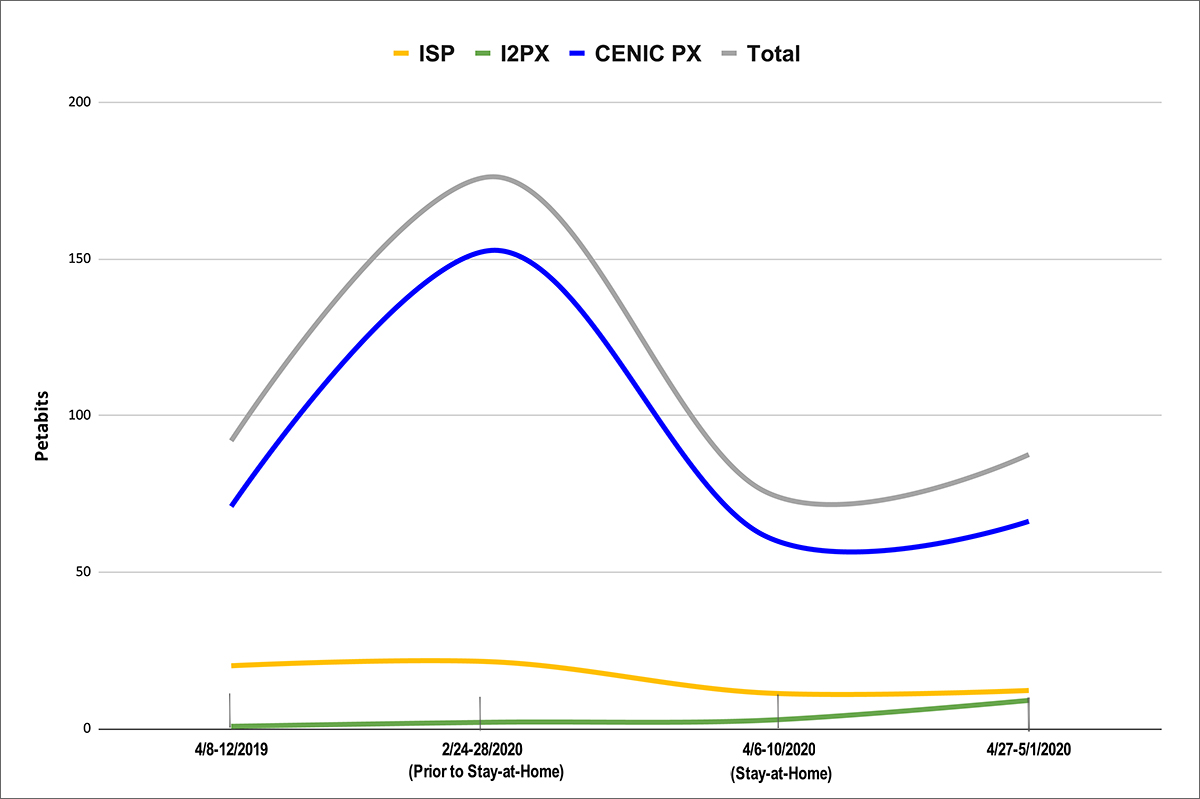- About
- Network
- Community
- Initiatives
- News
- Events
- Blog
- Publications

Network Traffic Analysis Shows Changing Activity Patterns During COVID-19 Pandemic
Categories CCCs CSU Cultural & Scientific University of California Healthcare K-12 Libraries Independent Universities RENS & NRENS Pacific Wave
Tags calren pacific wave
Even as campuses, schools, libraries, and cultural institutions have closed amid stay-at-home orders, CENIC’s networks have remained a vital part of the Internet ecosystem for online learning and community engagement, remote access to research data and specialized computing facilities, academic medicine and clinical care, and work-from-home operations. CENIC's robust connectivity has ensured continuity of service for our members, with reliable and affordable connections to meet their needs.
To understand how stay-at-home orders have affected network use, CENIC staff compiled traffic data comparing weekday usage before and after the orders. K-12 schools, libraries, California Community Colleges, California State University, University of California, and private universities continue to see significant network activity. Research universities and medical facilities have seen increased traffic.
Even with students and staff off of school and university campuses, the California Research and Education Network (CalREN) moved 162 Petabits in a recent week -- 78% of the traffic it did prior to the stay-at-home orders. As members have shifted to remote work, use of teleconferencing services such as Zoom and of high-performance virtual private network (VPN) paths to site-specific resources have dramatically increased to double previous amounts. CalREN has sufficient headroom and was able to support the transition seamlessly.
CalREN Transfer Volume-Total In/Out Petabits

Another one of CENIC’s networks, Pacific Wave International Peering Exchange, a joint project of CENIC and Pacific Northwest Gigapop (PNWGP), moved roughly the same amount of traffic that it did prior to the stay-at-home orders. Traffic on Pacific Wave, primarily research collaborations between California institutions and partners from around the globe, has increased in some data-intensive fields, including COVID-related research, as well as typically heavy network users like particle physics, astronomy, and climate science.
Analyzing Traffic Patterns
The types of services and applications in use across CalREN have changed with stay-at-home orders, as members use the network in new ways. Based on information for network ports, communication endpoints for specific Internet services, CENIC staff offered a few general comments regarding how traffic across CalREN has shifted.
Ingress traffic, traffic going to member institutions has decreased, while egress traffic, traffic coming from member institutions, remains high. The ratio of ingress to egress traffic has changed from about 1:3 to 1:5. Campuses appear to be providing content, in addition to content from cloud providers and home Internet Service Providers.
As expected, there has been a tremendous increase in traffic between CalREN and the various ISPs and cellular providers that our members are using from home. Traffic from both a large ISP and a large cellular provider have each increased by more than 1,000%. For non-Web traffic, applications that do not require a Web browser, the primary use prior to stay-at-home orders was for VPNs, email, and text messaging. After the stay-at-home orders, that use shifted to Zoom and VPNs, representing approximately 1 Petabyte of total traffic in a recent week.
Using Peering Connections
Internet peering connections continue to see significant usage with the majority being on CENIC’s internal peering infrastructure, CENIC Peering Exchange (CENIC PX). CENIC PX provides low-cost, settlement-free peering services, which connect member institutions to commercial peering entities ranging from home broadband providers to commercial cloud providers. CENIC’s settlement-free peering allows the exchange of traffic with other large networks, which supports routes and connection points to enhance network performance, offers caching strategies that bring content closer to users, and expands collaboration opportunities for CENIC members.
CENIC PX usage has remained consistent with last year. There has been a significant increase in traffic between CalREN and I2PX, the peering exchange for CENIC’s partner, the national research and education network Internet2. Usage of CENIC’s paid commodity Internet Service Provider connections continues to be about 60% of prior to stay-at-home levels.
CENIC PX Usage

Ensuring Robust Connectivity
CENIC staff constantly monitor and augment the network to ensure ample capacity to our peers, on-net caches, exchanges, and Internet Service Providers. To support changing traffic patterns associated with the pandemic, CENIC has:
- Increased capability to reach Zoom, Microsoft, and Google collaboration environments by tenfold,
- Improved diversity and resiliency to Zoom through five additional supplemental pathways,
- Increased headroom to home broadband providers by 20 times,
- Added 300 Gbps capacity to Cloud Services, adding to the many hundreds of Gigabits of existing capacity,
- Worked with private sector partners to get more broadband access points into parking lots at member sites, where broadband access is unavailable at home, and CENIC has the opportunity to extend this capacity to other institutions across our segments, as well as
- Developed a spectrum-sharing plan and agreement to assist some of our Charter Associate’s partner cities and counties (and their ISPs) who need access to broadband backhaul for temporary health care facilities that they have created or plan to create, if needed.
Providing Forward-Thinking Solutions
Forward-thinking investment in network infrastructure has allowed the CENIC network to adapt and to ensure uninterrupted continuity of education, research, clinical activities, and institutional operation during this unprecedented time. CENIC staff continue to work with partners to anticipate traffic changes that may occur in the fall as some institutions continue remote operations and others resume on-site activities. Network solutions now in progress include:
- Consolidating the Digital California (DC) and High-Performance Research (HPR) backbones, which gives members flexibility in how they use their connection, and
- Upgrading the optical backbone to next-generation 400G technology, including implementation of Contentionless Directionless Colorless (CDC) capabilities, which provide the ability to deploy channels with 400G and beyond, unify CalREN’s three discrete optical routes into one route, and repurpose wavelengths via software with no hands-on requirements.
Visit the CENIC Blog for more stories about the CENIC community. We’d love to hear example uses of how CENIC’s networks are supporting activities in your environments. Email us at cenicnews@cenic.org.
Related blog posts
CENIC and San Diego Supercomputer Center Create Sustainable Agriculture for California’s Future
CENIC’s networking and services, including CENIC AIR, can be a vital part of preparing new generations of farmers that will apply the latest technology to agriculture by turning the farm into an educational setting and improving the efficiency of farming as a career.
Advancing AI for California’s Community Colleges through Collaboration Across the CENIC Membership
It’s been eight months since the San Diego Community College District connected to CENIC AIR—and CENIC membership was essential at every step of the way.


